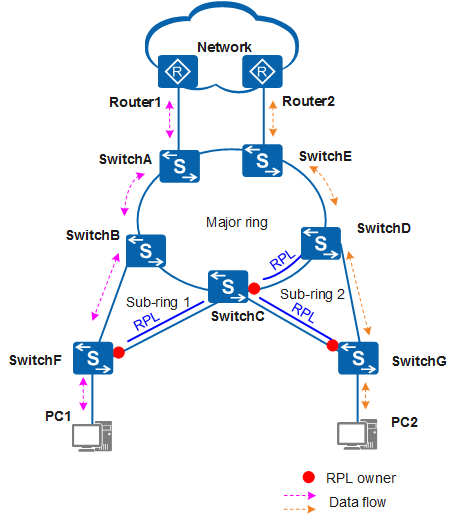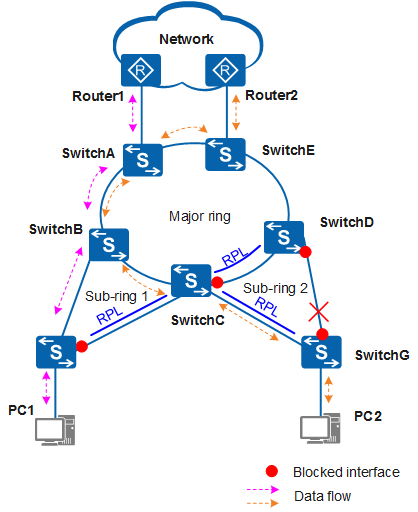ERPS Multi-ring Principles
Ethernet Ring Protection Switching Version 1 (ERPSv1) supports only single-ring topology, whereas ERPSv2 supports single-ring and multi-ring topologies.
A multi-ring network consists of one or more major rings and sub-rings. A sub-ring can have a virtual channel (VC) or non-virtual channel (NVC), depending on whether RAPS PDUs in the sub-ring will be transmitted to a major ring.
This section describes how ERPS is implemented on a multi-ring network where sub-rings use NVCs when links are normal, when a link fails, and when the link recovers.
Links Are Normal
On the multi-ring network shown in Figure 1, SwitchA through SwitchE constitute a major ring; SwitchB, SwitchC, and SwitchF constitute sub-ring 1, and SwitchC, SwitchD, and SwitchG constitute sub-ring 2. The LSWs in each ring can communicate with each other.
- To prevent loops, each ring blocks its RPL owner port. All other ports can transmit service traffic.
- The RPL owner port on each ring sends RAPS (NRRB) messages to all other nodes in the same ring at an interval of 5s. The RAPS (NRRB) messages in the major ring are transmitted only in this ring. The RAPS (NRRB) messages in each sub-ring are terminated on the interconnected nodes and therefore are not transmitted to the major ring.
Traffic between PC1 and the upper-layer network travels along the path PC1 -> SwitchF -> SwitchB -> SwitchA -> Router1; traffic between PC2 and the upper-layer network travels along the path PC2 -> SwitchG -> SwitchD -> SwitchE -> Router2.
A Link Fails
As shown in Figure 2, if the link between SwitchD and SwitchG fails, the ERPS protection switching mechanism is triggered. The ports on both ends of the faulty link are blocked, and the RPL owner port in sub-ring 2 is unblocked to send and receive traffic. In this situation, traffic from PC1 still travels along the original path. SwitchC and SwitchD inform the other nodes in the major ring of the topology change so that traffic from PC2 is also not interrupted. Traffic between PC2 and the upper-layer network travels along the path PC2 -> SwitchG -> SwitchC -> SwitchB -> SwitchA -> SwitchE -> Router2. The process is as follows:
- After SwitchD and SwitchG detect the link fault, they block their ports on the faulty link and update Filtering Database (FDB) entries.
- SwitchG sends three consecutive RAPS (SF) messages to the other LSWs and sends one RAPS (SF) message at an interval of 5s afterwards.
- SwitchG then unblocks the RPL owner port and updates FDB entries.
- After the interconnected node SwitchC receives an RAPS (SF) message, it updates FDB entries. SwitchC and SwitchD then send RAPS Event messages within the major ring to notify the topology change in sub-ring 2.
- After receiving an RAPS Event message, the other LSWs in the major ring update FDB entries.
Then traffic from PC2 is switched to a normal link.
The Link Recovers
After the link fault is rectified, either of two situations may occur:
- If the ERPS ring uses revertive switching, the RPL owner port is blocked again, and the link that has recovered is used to forward traffic.
- If the ERPS ring uses non-revertive switching, the RPL remains unblocked, and the link that has recovered is still blocked.
The following example uses revertive switching to illustrate the process after the link recovers.
- After the link between SwitchD and SwitchG recovers, SwitchD and SwitchG start the Guard timer to avoid receiving out-of-date RAPS PDUs. The two devices do not receive any RAPS PDUs before the timer expires. Then SwitchD and SwitchG send RAPS (NR) messages within sub-ring 2.
- SwitchG on which the RPL owner port resides starts the WTR timer. After the WTR timer expires, SwitchG blocks the RPL owner port and unblocks its port on the link that has recovered and then sends RAPS (NR, RB) messages within sub-ring 2.
- After receiving an RAPS (NR, RB) message from SwitchG, SwitchD unblocks its port on the recovered link, stops sending RAPS (NR) messages, and updates FDB entries. SwitchC also updates FDB entries.
- SwitchC and SwitchD (interconnected nodes) send RAPS Event messages within the major ring to notify the link recovery of sub-ring 2.
- After receiving an RAPS Event message, the other LSWs in the major ring update FDB entries.
Then traffic changes to the normal state, as shown in Figure 1.

